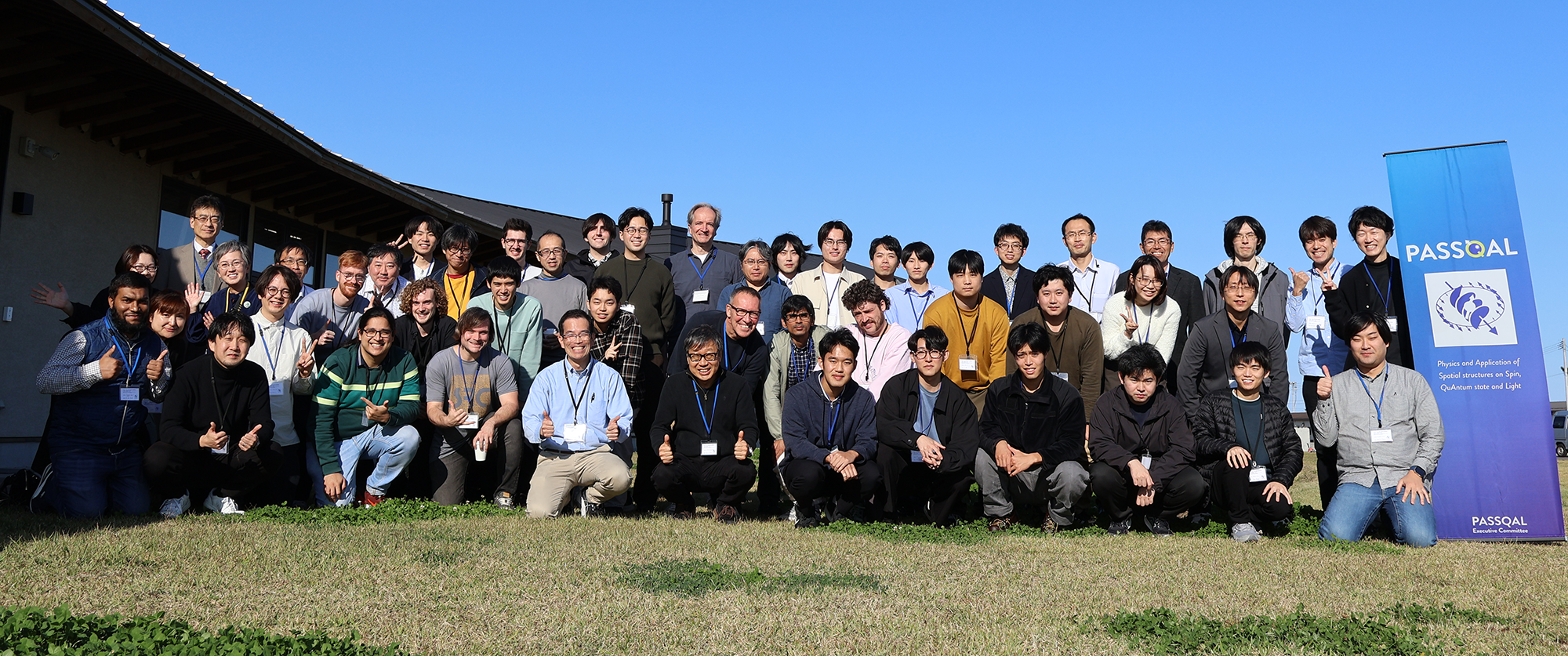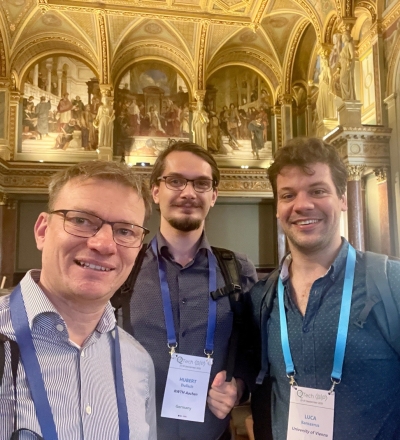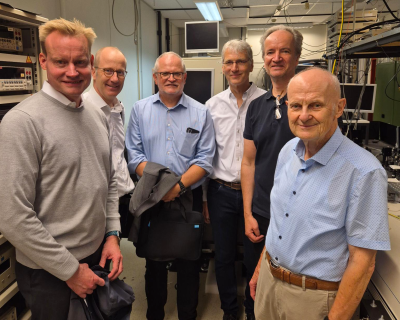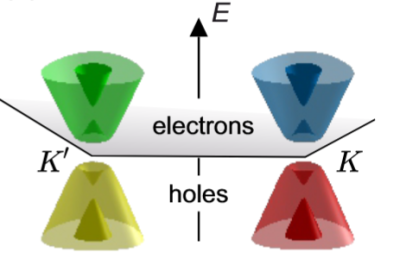Current events
Next talk tomorrow at 11:00 by Simone Sotgiu!
News 11.11.2025
New publication: Tailoring Phonon Polaritons in hBN with the Plasmonic Phase-Change Material In3SbTe2
Site Content:
11.11.2025
New publication: Tailoring Phonon Polaritons in hBN with the Plasmonic Phase-Change Material In3SbTe2

Nano Letters 25, 15809 (2025) Polaritons in van-der-Waals materials (vdWMs) promise high confinement and multiple tailoring options by resonators and launching structures which conventionally require cumbersome lithography techniques. Optical programming of phase-change materials (PCMs) offers fast and reconfigurable fabrication of these structures. As the plasmonic PCM In3SbTe2 can be switched between a dielectric and metallic phase, In3SbTe2 is promising for optical programming of metallic launching structures to tailor and confine polaritons in vdWMs. Here, we combine the vdWM hexagonal boron nitride (hBN) with In3SbTe2 and optically program circular resonators for hBN’s phonon polaritons into In3SbTe2. We investigate the polariton resonators with near-field optical microscopy. Demonstrating the reconfigurability, we decrease the resonator diameter to increase the confinement up to λ/39 and achieve a quality factor of 72. Finally, we fabricate a focusing structure for hBN’s polaritons whose focal point we reconfigure. We promote In3SbTe2 as a versatile platform for rapid prototyping of polariton optics in vdWMs.

28.10.2025
Visit of PASSQAL workshop in Sendai
Bernd Beschoten gave a talk on the magnetic phases in bilayer graphene at the 2nd PASSQAL Workshop in Sendai. The workshop on "physics and application of spatial structures on spin, quantum state and light" was hosted by Prof. Makoto Kohda from Tohoku University.


30.09.2025
Bilayer Graphene Quantum Dots at QTech-Bp in Budapest
Two of our group members, Hubert Dulisch and Christoph Stampfer, presented the recent results on bilayer graphene quantum dots in the SpinQubits workshop at the QTech-Bp meeting in Budapest. The conference was hosted at the Hungarian Academy of Sciences (an impressive building), celebrating its 200th anniversary alongside 100 years of quantum mechanics. Besides the stimulating scientific program, we had great fun reconnecting with former group members.


15.09.2025
Our group at the 2nd DPG Fall Meeting: 100 Years of Quantum Physics
Christian Volk and Christoph Stampfer from our group actively participated in the 2nd DPG-Herbsttagung 100 Years of Quantum Physics, held from 8–12 September 2025 at Georg-August-Universität Göttingen. Their contributions highlighted our ongoing research quantum dots in bilayer graphene. We are happy to have been part of this special event marking the International Year of Quantum.

09.09.2025
PhD anniversary
As part of this year’s RWTH anniversary celebration of the 1999 graduating class, it was a great pleasure for us to welcome some of the former graduates back to the research facility of the 2nd Institute of Physics. (The jubilarians from left to right: Dr. Michael Fischer, Dr. Frank Dillmann, Dr. Jochen Dreßen, Dr. Andreas Rosenberger. Hosts at the institute: Dr. Bernd Beschoten and Prof. Dr. emer. Gernot Güntherodt)."


19.08.2025
New publication: Current-induced brightening of vacancy-related emitters in hexagonal boron nitride

Phys. Rev. Research 7, L032037 (2025) We perform photoluminescence measurements on vacancy-related emitters in hexagonal boron nitride (hBN) that are notorious for their low quantum yields. The gating of these emitters via few-layer graphene electrodes reveals a reproducible, gate-dependent brightening of the emitter, which coincides with a change in the direction of the simultaneously measured leakage current across the hBN layers. At the same time, we observe that the relative increase of the brightening effect scales linearly with the intensity of the excitation laser. Both observations can be explained in terms of a photo-assisted electroluminescence effect. Interestingly, emitters can also show the opposite behavior, i.e., a decrease in emitter intensity that depends on the gate leakage current. We explain these two opposing behaviors by different concentrations of donor and acceptor states in the hBN and show that precise control of the doping of hBN is necessary to gain control over the brightness of vacancy-related emitters by electrical means. Our findings contribute to a deeper understanding of vacancy-related defect emitters in hBN that is necessary to make use of their potential in quantum information processing.

22.07.2025
New publication: Recitation tasks revamped? Students’ perceptions of smartphone-based experimental and programming tasks in introductory mechanics

Phys. Rev. Phys. Educ. Res. 21 020110 (2025) This exploratory field study investigates the integration of innovative forms of recitation tasks in a first-year introductory mechanics course, focusing on smartphone-based experimental tasks alongside programming and standard recitation tasks. Smartphones, combined with external sensor modules, serve as a gateway enabling students to conduct various low-cost and authentic physics experiments with first-hand data collection outside traditional lab settings. These tasks aim to enhance students’ agency in independent physics experimentation and enrich homework assignments by dissolving boundaries between lectures, recitation sessions, and traditional labs, and thereby linking theoretical and experimental aspects of undergraduate physics education. To explore this potential, we implemented and evaluated a sample set of nine smartphone-based experimental tasks and, for comparison, three programming tasks as weekly exercises in a first-year physics course at RWTH Aachen University. We investigated students’ perceptions of learning with these new tasks through twelve short surveys involving up to 188 participants, focusing on factors such as goal clarity, difficulty, or feasibility at home. In two additional surveys with 108 and 78 participants, students assessed affective responses to the smartphone-based experimental tasks relative to the programming and standard recitation tasks. Our findings indicate that the smartphone-based experimental tasks were generally well-suited to the students and tended to outperform the programming tasks in terms of perceptions of learning with the tasks and affective responses. Overall, students responded positively to the new experimental tasks, with perceptions comparable to, or only partly below, those of long-established standard recitation tasks. These results suggest that smartphone-based experimental tasks can be successfully integrated into teaching and contribute to refining traditional recitation tasks. Students’ differentiated perceptions of the three task types investigated offer valuable insights into how students perceived technology-enhanced recitation tasks in terms of feasibility, engagement, and instructional value. This provides a meaningful basis for instructors and researchers aiming to design more effective and student-centered learning environments in undergraduate physics education.

10.07.2025
New publication: Phonon-limited valley lifetimes in single-particle bilayer graphene quantum dots

Phys. Rev. B 112, 035409 (2025) The valley degree of freedom in 2D semiconductors, such as gapped bilayer graphene (BLG) and transition metal dichalcogenides, is a promising carrier of quantum information in the emerging field of valleytronics. While valley dynamics have been extensively studied for moderate band gap 2D semiconductors using optical spectroscopy techniques, very little is known about valley lifetimes in narrow band gap BLG, which is difficult to study using optical techniques. Here, we report single-particle valley relaxation times (T1) exceeding several microseconds in electrostatically defined BLG quantum dots using a pulse-gating technique. The observed dependence of T1 on perpendicular magnetic field can be understood qualitatively and quantitatively by a model in which T1 is limited by electron-phonon coupling. We identify the coupling to acoustic phonons via the bond length change and via the deformation potential as the limiting mechanisms.

Showing 1 - 8 (237 total) - Next
